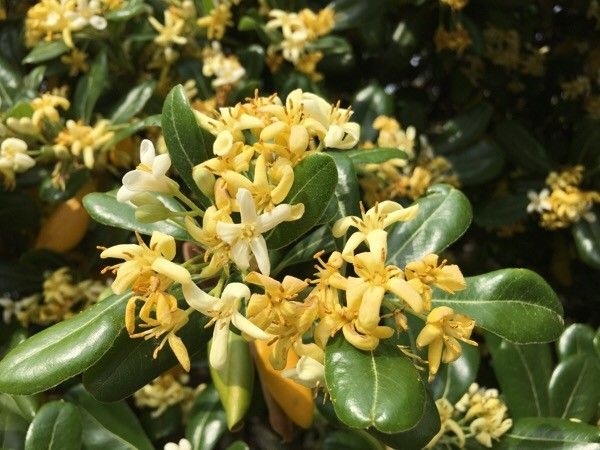Japanese Mock Orange
(Pittosporum tobira)
Japanese Mock Orange (Pittosporum tobira)
/
/

sylvie ducharne
CC BY-SA 4.0
Image By:
sylvie ducharne
Recorded By:
Copyright:
CC BY-SA 4.0
Copyright Notice:
Photo by: sylvie ducharne | License Type: CC BY-SA 4.0 | License URL: https://creativecommons.org/licenses/by-sa/4.0/ | Attribution: sylvie ducharne (cc-by-sa) | Rights Holder: sylvie ducharne | Publisher: PlantNet | Date Created: 2018-05-06T16:52:59Z | Title: Pittosporum tobira (Thunb.) W.T.Aiton: flower | Notes: |












































































































Estimated Native Range
Summary
Pittosporum tobira, commonly known as Japanese mock orange, Australian laurel, Japanese pittosporum, and Japanese cheesewood, is an evergreen shrub native to coastal regions and forest margins in Japan (south of Kanto), China, Taiwan, and Korea. It is widely used as an ornamental plant for its sweet-smelling, white flowers and glossy, leathery leaves. This species typically grows to 10 m (33 ft) tall and 3 m (10 ft) wide, often taking on a tree-like form with age but can be pruned into a hedge or shaped for topiary. The inflorescence consists of clusters of fragrant flowers at the branch tips, each with five white petals about a centimeter long, blooming in late spring to early summer. The flowers are particularly showy due to their abundance and fragrance.
Pittosporum tobira is valued for its drought tolerance, low maintenance, and ability to thrive in a Mediterranean climate. It is commonly used for hedges, living privacy screens, and in indoor and outdoor planter boxes. The stems, leaves, and dried fruits are also popular in floral arrangements. Cultivars like the dwarf forms and ’Variegata’ with variegated leaves are particularly sought after. It prefers full sun to part shade, well-drained soil, and can tolerate a range of soil types. While generally hardy, it may be more sensitive to drought-induced stress than other common ornamental plants. It is potentially invasive in some regions, so it is important to check local guidelines before planting.CC BY-SA 4.0
Pittosporum tobira is valued for its drought tolerance, low maintenance, and ability to thrive in a Mediterranean climate. It is commonly used for hedges, living privacy screens, and in indoor and outdoor planter boxes. The stems, leaves, and dried fruits are also popular in floral arrangements. Cultivars like the dwarf forms and ’Variegata’ with variegated leaves are particularly sought after. It prefers full sun to part shade, well-drained soil, and can tolerate a range of soil types. While generally hardy, it may be more sensitive to drought-induced stress than other common ornamental plants. It is potentially invasive in some regions, so it is important to check local guidelines before planting.CC BY-SA 4.0
Plant Description
- Plant Type: Tree, Shrub
- Height: 10-15 feet
- Width: 10-15 feet
- Growth Rate: Moderate
- Flower Color: Cream, White
- Flowering Season: Spring
- Leaf Retention: Evergreen
Growth Requirements
- Sun: Full Sun, Part Shade
- Water: Medium
- Drainage: Fast, Medium
Common Uses
Bee Garden, Bird Garden, Border Plant, Butterfly Garden, Deer Resistant, Drought Tolerant, Fragrant, Hedges, Hummingbird Garden, Low Maintenance, Potted Plant, Salt Tolerant, Showy Flowers, Street Planting
Natural Habitat
Coastal regions and forest margins in Japan, China, Taiwan, and Korea
Other Names
Common Names: Japanese Cheesewood, Japanese Pittosporum, Australian Laurel, Chinesischer Klebsame, Pechsame, Glansbuske, 돈나무, Tobira, Japanse Tobira, Klebsamenstrauch
Scientific Names: , Pittosporum tobira, Pittosporum chinense, Euonymus tobira, Pittosporum tobira var. chinense, Pittosporum tobira var. tobira,
GBIF Accepted Name: Pittosporum tobira (Murray) Aiton fil.